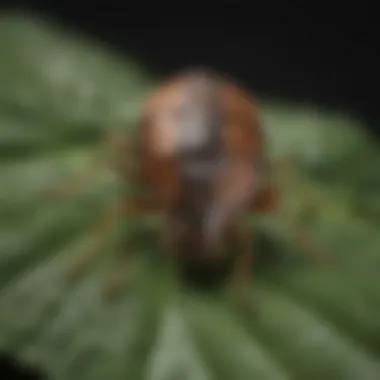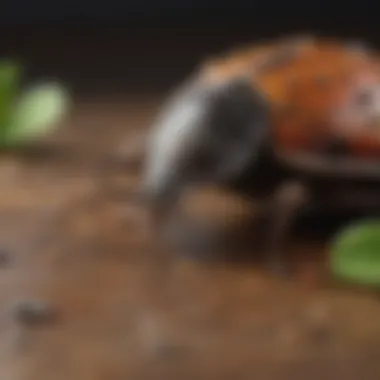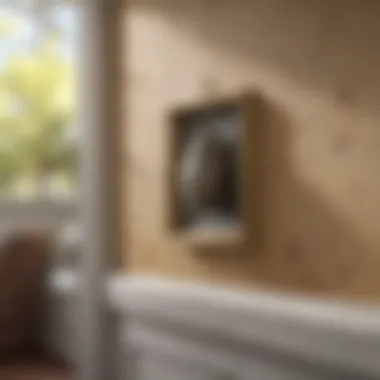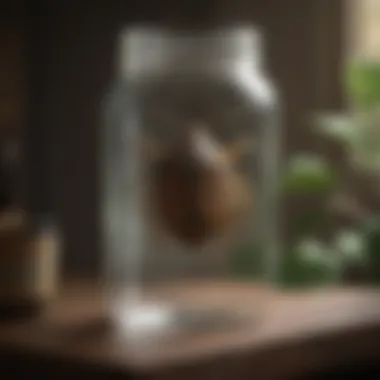Effective Strategies for Stink Bug Control


Intro
Stink bugs are a common problem for many homeowners, especially during the fall and winter months. These pests often invade homes looking for warmth and shelter. Their distinct odor can be quite the annoyance, making it essential to understand how to deal with them effectively. This article will delve into the practical approaches to manage and eliminate stink bugs from your home.
From identifying these pests to exploring various prevention strategies and treatment options, this narrative aims to equip housewives and homeowners with the necessary tools to maintain a bug-free environment. Understanding the behavior and biology of stink bugs can aid in informed decision-making in pest control, contributing significantly to a more comfortable living space.
Understanding Stink Bugs
Understanding stink bugs is crucial for effective management of these pests. This section aims to provide homeowners with knowledge about their behavior and biology. The more you know, the better prepared you are to tackle the problems these pests may cause. Recognizing their habits can lead to preventive measures that mitigate their impact.
Defining Stink Bugs
Stink bugs are a family of insects called Pentatomidae. They are characterized by their shield-like shape and distinctive odor, which they release as a defense mechanism. These pests typically measure between 1/2 to 3/4 inch in length and display various colors, including green, brown, or even reddish hues. Identifying stink bugs early is essential to prevent an infestation.
They invade homes in large numbers, especially during the fall and spring seasons, seeking warmth and shelter. Their presence can be a nuisance, as they often congregate near windows and doors. Understanding what stink bugs are and how they behave gives you a significant advantage in controlling them.
Biology and Behavior
The biology of stink bugs reveals interesting aspects of their behavior. They are primarily herbivorous, feeding on the sap of plants. This feeding can cause extensive damage to crops and gardens, making them more than just a nuisance in residential areas. Stink bugs thrive in warm climates, which is why they are often found invading homes during colder months. Their activity peaks during twilight hours when they are most likely to forage for food.
Stink bugs are known for their unique social behavior; they often aggregate in groups. This behavior can lead to large swarms being found together, particularly in autumn. Additionally, they have developed a resistance to certain pesticides, making it challenging for homeowners to eradicate them once they establish a presence.
The Life Cycle of Stink Bugs
The life cycle of stink bugs is composed of four main stages: egg, nymph, adult, and overwintering. Adult stink bugs mate in the spring, laying clusters of eggs on the underside of leaves. These eggs hatch into nymphs, which resemble miniature versions of adults but lack wings. As nymphs grow, they undergo five molts before reaching adulthood.
An important aspect of their life cycle is the overwintering phase. During colder months, stink bugs find sheltered spots in and around homes, leading to potential infestations in the spring. Recognizing this cycle helps homeowners target their control methods effectively, particularly in the fall when stink bugs are looking for places to overwinter.
Knowing the life cycle of stink bugs enables you to anticipate their behavior and implement control measures at crucial times.
In summary, understanding stink bugs involves recognizing their definition, biology, and life cycle. With this knowledge, homeowners can more effectively combat these pests, ensuring that their homes remain comfortable and free of unwanted invaders.
Identifying Stink Bugs
Identifying stink bugs is a critical step in managing these nuisances effectively. Recognizing stink bugs allows homeowners to determine the pest type, enabling them to choose the most suitable elimination and prevention strategies. Accurate identification also avoids confusion with other insects. Awareness of their common species enhances the understanding of their behavior and habitat preferences, leading to informed pest management decisions.
Common Species of Stink Bugs
Stink bugs belong to the family Pentatomidae, which comprises various species. The most prominent species encountered often include:
- Brown Marmorated Stink Bug (Halyomorpha halys): This species is easily identifiable by its mottled brown appearance and distinctive shield shape. Brown marmorated stink bugs are notorious for infesting homes in search of warmth during colder months.
- Green Stink Bug (Chinavia hilaris): True to its name, this species displays a vibrant green color. It tends to feed on fruit and vegetables, posing a risk to home gardens.
- Brown Stink Bug (Euschistus servus): This species has a primarily brown appearance. Known for their sporadic appearances in homes, they are particularly drawn to agricultural fields.
Understanding these species is essential because they have different behaviors and habitat preferences. Knowledge about them helps homeowners to identify similar-looking insects more accurately.
Signs of Infestation
Recognizing the signs of stink bug infestation is paramount for timely management. The following indicators can point to a stink bug presence:


- Unexpected Odor: Stink bugs emit a distinct odor when disturbed; this is a primary giveaway of an infestation nearby.
- Visible Bugs: Spotting stink bugs during their active periods is a strong sign of infestation, especially around windows or doors.
- Presence of Eggs: Eggs are often found on plant leaves or indoors during warmer months. These are small and pale in color, making them hard to detect but essential for recognition.
- Damage to Plants: If you notice unusual discoloration or deformities in garden plants, it may indicate an infestation, especially from species like green stink bugs.
Proper identification and awareness of these signs can significantly help in preventing further infestations and mitigating any potential damages.
Effective management begins with knowing precisely what to look for, making these indicators crucial for homeowners. Having this knowledge ensures that you do not waste time or resources on unnecessary measures when dealing with stink bugs.
Natural Methods for Stink Bug Control
Natural methods for controlling stink bugs are increasingly valued for their effectiveness and environmental safety. These approaches often have fewer side effects on humans, pets, and the ecosystem compared to chemical insecticides. Utilising natural solutions can provide a more sustainable way to manage stubborn infestations. This segment will delve into various natural methods, such as essential oils, diatomaceous earth, and homemade traps, all of which offer unique benefits with particular considerations.
Essential Oils for Repulsion
Essential oils serve as a potent natural repellent for stink bugs. Many essential oils, like peppermint, lavender, and eucalyptus, contain compounds that are displeasing to these pests. The strong fragrances of these oils mask the scents that attract stink bugs and can create an environment that deters them.
To use essential oils effectively, mix a few drops of your chosen oil with water in a spray bottle. Shake well and spray around entry points, such as doors and windows. Be sure to reapply this mixture regularly, especially after rain or heavy winds, as outdoor elements can reduce its effectiveness.
"Essential oils are not only fragrant; they can be a simple yet effective solution for preventing stink bugs from entering your home."
Diatomaceous Earth as a Deterrent
Diatomaceous earth is another natural method with a unique approach. This fine powdery substance is made from fossilized aquatic organisms called diatoms. When stink bugs come into contact with it, the tiny, sharp particles damage their exoskeletons, leading to dehydration and death. It is important to choose food-grade diatomaceous earth as it is safe for use around children and pets.
To apply, sprinkle diatomaceous earth around areas where you suspect stink bugs may enter your home. It can be used both indoors and outdoors. Regular application will ensure continued protection. This method is not a quick fix, as it may take time for the pests to come into contact with the powder, but it is a long-term and sustainable solution.
Homemade Traps
Creating homemade traps is a practical and economical approach to managing stink bugs. These traps can effectively catch stink bugs while minimizing the use of chemicals. One effective trap is a simple water and soap solution. To make this trap, fill a dish or shallow pan with water and add a few drops of dish soap. The soap breaks the surface tension of the water, causing the stink bugs to sink and drown when they land.
Place the traps in areas where stink bugs are commonly seen, especially near any entry points. It will be necessary to empty and refresh the traps regularly to maintain their efficiency. In addition to water traps, light traps can also be created using a desk lamp and a shallow bowl of soapy water placed underneath.
Chemical Solutions for Stink Bugs
The topic of chemical solutions for managing stink bugs holds significant relevance for homeowners seeking immediate and effective pest control options. Stink bugs can produce substantial damage to plants and crops, alongside the discomfort they bring when invading homes. Utilizing chemical insecticides introduces a direct approach to eliminating these pests, potentially offering a quick resolution. However, it is essential to balance efficacy with safety, both for family members and the environment. This section aims to provide comprehensive insights into the types of chemical insecticides available, their applications, and critical considerations for usage.
Overview of Chemical Insecticides
Chemical insecticides are formulated substances that target specific pests, including stink bugs. Among the most common types used for stink bug control are pyrethroids, neonicotinoids, and insect growth regulators. These products function by disrupting the insect's nervous system or interfering with its growth processes.
- Pyrethroids: These are synthetic chemicals modeled after natural pyrethrins, derived from chrysanthemum flowers. They offer broad-spectrum effectiveness against various insects, including stink bugs.
- Neonicotinoids: Systems that affect the nicotine receptors within the bugs, leading to paralysis or death. They are effective as both soil and foliar treatments.
- Insect Growth Regulators (IGRs): These disrupt the normal development of insects, preventing growth into nuisance-adult forms.
While these insecticides can significantly reduce stink bug populations, homeowners should consider the potential impact on beneficial insects and pollinators. Always read labels carefully to ensure pests are targeted without harming the ecosystem.
Application Methods
Efficient application of chemical insecticides is crucial for effective stink bug control. The method chosen can influence both effectiveness and safety. Here are some common application techniques:
- Spraying: This method involves applying a liquid solution directly to infested areas. It can be done using a handheld sprayer or larger equipment, depending on the scale of infestation.
- Drenching: Applied at the soil level, drenching involves saturating the soil around the plants to target pests that feed on roots.
- Granular application: This involves scattering pellets or granules onto the ground or around plant bases. It is particularly useful for preventing pests from moving into garden spaces.


It is crucial to apply insecticides during the times when stink bugs are most active. This often means treating in the early morning or late evening. Homeowners should also take care to wear protective gear during application to minimize exposure to chemicals.
"Proper timing and application methods are essential in maximizing the effectiveness of chemical solutions against stink bugs."
In summary, chemical solutions can play a significant role in managing stink bug populations, but they come with responsibilities and considerations. Understanding the types of insecticides, their effects, and application methods will help homeowners make informed decisions for effective pest control.
Preventive Measures
Preventive measures are crucial in managing stink bugs. By addressing potential entry points and adapting your surroundings, you can significantly reduce the chances of infestation. These strategies not only help in keeping stink bugs away but also save time, effort, and money that would otherwise be spent on removal or pest control services. Implementing preventive measures leads to a proactive approach, ensuring your home remains less appealing to these pests.
Sealing Entry Points
Sealing entry points is one of the most effective strategies. Stink bugs often find their way indoors through small cracks and crevices. Here are several steps to enhance your home’s defenses:
- Inspect Windows and Doors: Ensure that all windows and doors fit securely. Look for gaps where air leaks through, as these can be easy entry points. Installing or replacing weather stripping can help seal out unwanted pests.
- Close Off Cracks: Examine the exterior walls for any cracks or gaps, especially around vents, utility lines, and electrical outlets. Use caulk or expanding foam to fill these voids. This not only keeps stink bugs out but also improves energy efficiency.
- Repair Screens: Ensure that window and door screens are intact. Any holes can serve as gateways for insects, including stink bugs. Replacing or repairing torn screens is a relatively easy fix that can offer significant protection.
Taking these actions minimizes the chances of a stink bug invasion. It is important to conduct regular checks, especially before fall, when these bugs are most likely to seek shelter indoors.
Landscaping Techniques
Landscaping can also influence the presence of stink bugs. By making strategic choices in your outdoor area, you can deter these pests from approaching your home. Consider these techniques:
- Maintain Distance: Keep a clear zone of at least 2 to 3 feet between the foundation of your home and any vegetation or mulch. This distance can help prevent stink bugs from climbing directly into your home.
- Choose the Right Plants: Some plants attract stink bugs more than others. For example, avoid planting fruit trees too close to your house. Instead, consider using less inviting plants in your garden. Flowering plants that do not produce fruit can be a better choice.
- Regular Cleanup: Keep your yard tidy. Remove fallen fruit, leaves, and debris, as these can provide hiding spots for stink bugs. Regularly cleaning up your yard helps eliminate potential habitats and makes your property less inviting.
This approach can lead to a more manageable outdoor space where stink bugs are less likely to thrive.
Environmental Controls
Environmental controls play a significant role in controlling stink bug populations. By modifying the environment, you can create less favorable conditions for these pests:
- Reduce Lighting: Stink bugs are attracted to light. Using yellow outdoor light bulbs can help, as these bulbs attract fewer insects. Consider using motion-sensor lighting to minimize constant illumination, reducing draw to your home.
- Encourage Natural Predators: Creating a welcoming environment for birds and insects that prey on stink bugs can help control their numbers. Consider building birdhouses or planting native flowers that attract beneficial insects.
- Keep Food Sources Limited: Store food in airtight containers and dispose of debris or any possible food source. Limiting access to food discourages stink bugs from settling in your home.
By implementing these environmental control measures, you can create an inhospitable environment for stink bugs, making your home less likely to attract them.
Through consistent application of these preventive strategies, homeowners can ensure their living spaces remain protected from these resilient pests.
The Role of Professional Pest Control
Professional pest control plays a vital role in effectively managing stink bug infestations. While homeowners can implement various natural and chemical methods, professional services offer comprehensive solutions tailored to address specific pest challenges. The expertise provided by trained pest control specialists can save time and reduce the frustration associated with ineffective DIY methods.
One of the primary advantages of hiring professionals is their knowledge of pest behavior and biology. Understanding the habits of stink bugs allows pest control experts to deploy targeted strategies, increasing the likelihood of success. Moreover, professionals have access to advanced tools and products, which may not be available to the average homeowner. This can include specialized insecticides that are not only more effective but also safer for household use when applied by qualified individuals.
When considering pest control services, it is crucial to engage with licensed and experienced companies. They will know local regulations regarding pesticide use and can ensure compliance while minimizing risks to your family and pets. The initial consultation often includes an assessment of your home, identification of potential entry points, and customized treatment plans. These features emphasize the importance of professional intervention for a long-term solution to stink bug problems.
"Professional pest control not only targets the insects you see but also addresses underlying issues that could lead to further infestations."
When to Seek Professional Help


Recognizing the right moment to call in professionals can enhance the effectiveness of pest control. Homeowners should consider seeking professional help when:
- Infestation Level: The presence of a large number of stink bugs exceeds manageable levels. If DIY methods do not yield positive results after a reasonable period, it's time to escalate the situation.
- Continued Presence: When stink bugs keep returning despite preventive measures being taken, it indicates possible entry points or nests that need professional evaluation.
- Health Concerns: Any concerns regarding potential allergies or illnesses caused by contact with stink bugs urge homeowners to consult experts for safe removal.
- Time Constraints: If managing the situation becomes too time-consuming or overwhelming, professional help can provide relief and effective outcomes.
Evaluating Pest Control Services
Choosing the right pest control service requires careful consideration. Here are some key factors to keep in mind:
- Reputation: Research online reviews or ask for recommendations from friends and family to find reputable pest control companies.
- Experience: Inquire about the company's experience specifically with stink bug infestations. A well-versed professional will have a track record of successful interventions.
- Treatment Plans: Ask about the specific treatment methods proposed and how they align with your needs, such as using environmentally friendly options or integrated pest management strategies.
- Cost Estimates: Ensure you receive transparent pricing without hidden fees. Understanding the total cost upfront helps in budget planning.
- Follow-Up Services: Evaluate whether the company offers follow-up visits or monitoring services, which can be crucial in preventing re-infestation.
By considering these factors, homeowners can make informed decisions when selecting pest control services, ensuring a thorough and effective approach to eliminating stink bugs.
Understanding Stink Bug Resistance
Understanding stink bug resistance is critical for homeowners who face recurring infestations. As these pests adapt to their environment and control methods, it becomes increasingly important to stay informed about the factors contributing to their resilience. This section discusses the reasons behind stink bug resistance and its implications for pest control strategies.
Factors Leading to Resistance
Stink bugs can develop resistance to various pesticides. This resistance can stem from several factors:
- Genetic Variation: Some stink bugs possess genes that enable them to survive certain chemical exposures. Through natural selection, these resistant individuals reproduce, leading to a population that is more difficult to control.
- Overuse of Chemicals: Constant reliance on the same pesticides can lead to resistance. When a particular chemical is used repeatedly, stink bugs that survive become the basis for the next generation, often resulting in a more resistant population.
- Environmental Influences: Habitat conditions and the availability of food can impact a stink bug's resilience. Favorable environmental conditions may enhance their ability to survive even when exposed to potential control measures.
- Behavioral Adaptations: Stink bugs can change their behavior in response to threats. They may find ways to avoid traps or select habitats that buffer their exposure to pesticides.
Implications for Control Methods
Acknowledging stink bug resistance has direct consequences for homeowners and pest control professionals alike. Understanding these implications can inform better strategies for managing infestations:
- Diverse Control Strategies: To mitigate resistance, it is essential to employ a variety of control methods. This could include alternating different pesticides and integrating natural methods or mechanical traps to weaken the population dynamically.
- Monitoring Pesticide Effectiveness: It becomes necessary to regularly assess the effectiveness of chosen control methods. Knowing when a pesticide fails enables homeowners to switch tactics before resistance becomes fully established.
- Public Awareness and Education: Homeowners should educate themselves about stink bug behavior and resistance. Workshops and informational sessions can help communities understand the lifecycle and environmental needs of stink bugs, promoting proactive measures rather than reactive ones.
- Collaborative Approaches: Pest control professionals and homeowners should work together in crafting an integrated pest management plan. Sharing data on infestations and the effectiveness of strategies fosters community-wide awareness and responsiveness.
"Understanding the resistance patterns of stink bugs allows homeowners to adapt their strategies effectively. This adaptability is key to controlling these pests long-term."
By grasping the factors contributing to stink bug resistance and the implications for control methods, homeowners can make informed decisions. The fight against these pests involves not only immediate actions but also proactive steps aimed at minimizing their ability to adapt.
Epilogue and Future Directions
The topic of eliminating stink bugs is essential for homeowners who wish to maintain a comfortable living environment. Stink bugs not only disrupt daily life but also threaten the integrity of crops and gardens. In this article, we have explored various approaches to manage and eradicate these pests, addressing both natural and chemical methods. These insights empower readers to make informed choices, either by applying specific techniques themselves or by seeking professional assistance when necessary.
Summary of Key Insights
Throughout the article, we discussed the biology and behavior of stink bugs, which plays a crucial role in understanding how to combat their presence effectively. Identifying the pests through common signs of infestation allows homeowners to respond promptly. The two main approaches highlighted were natural solutions, such as essential oils and diatomaceous earth, and chemical solutions, including commercially available insecticides. Preventive measures were discussed extensively, emphasizing the importance of sealing entry points and appropriate landscaping to deter stink bugs.
Key points include:
- Understanding stink bugs’ life cycle aids in timing control efforts.
- Utilizing natural repellents can be a safe alternative for families.
- Regular home maintenance can significantly reduce risks of infestation.
Future Research Areas
While various strategies exist to manage stink bugs, future research can enhance our understanding and methods of control. Potential areas for further study include:
- Development of more effective organic repellents that are safe for household use.
- Understanding stink bug resistance to common insecticides to improve product formulations.
- Long-term ecological impacts of stink bug control measures on local environments.
- Exploring biological control options, such as beneficial insects that prey on stink bugs.
Research efforts in these areas can lead to innovative solutions, ultimately benefiting homeowners and preserving ecological balance. By keeping abreast of the latest findings and methodologies, we can work towards more sustainable and effective pest management solutions.
"Innovative solutions in pest control not only solve immediate problems but also foster a healthier environment for all of us."
Through a nuanced understanding of stink bugs and continued exploration into management techniques, homeowners can better prepare for the inevitability of these pests, ensuring their homes remain safe and pest-free.



